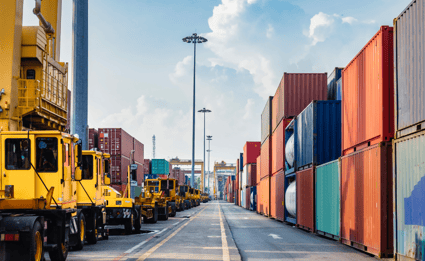How to Improve Inbound Transportation
Keith LaBotz - February 16, 2023

One of the world’s largest automotive parts manufacturers improved inbound transportation, reducing carbon emissions and logistics costs. The key was optimizing transportation planning across the enterprise and supplier base, and this case study explains how they did it.
The company is a multinational corporation based in Canada, with 347 manufacturing facilities in 28 countries. Like many manufacturers, it relied on ERP software (SAP) and used call-off orders to manage supplier shipments.
ERP software rarely includes transportation details in its production and supplier ship dates calculation. Consequently, ERP demand dates drive supplier shipping without regard for their impact on transportation, and it’s not unusual for half-empty trucks to deliver orders.
In this case, the number of partial trucks delivering supplier shipments presented an attractive opportunity to the company for cost savings and shrinking its CO2 footprint.
The Challenge of Inbound Transportation
The opportunity was a luscious piece of fruit at the top of the tree - visible but only reachable with help. Optimizing inbound transportation is one of the most difficult challenges in the supply chain for several reasons:
- The recipient has no control over supplier shipping operations.
- Inbound involves multiple suppliers utilizing different transportation technologies, logistics service providers, and modes of transport.
- Supplier capabilities vary, making collaboration difficult, and digitalization may create an agility gap, increasing these differences.
While the factory could not control supplier shipping processes, it did control production and call-off dates in its ERP system governing supplier shipments. The ability to adjust shipping and production dates to enable better transportation capacity utilization would achieve the objectives of reducing cost and emissions without compromising reliability.
Customer Requirements for Inbound Freight Optimization
The company began to search for a dynamic leveling solution that would more effectively utilize truck capacity to minimize cost and carbon footprint by adjusting demand-based production planning and supplier ship dates.
- A transportation planning solution that integrates with existing ERP (SAP), demand and production planning, and transportation management systems.
- Interface with freight forwarders and real-time tracking platform to enable transparency for all parties in the inbound chain.
- Supplier shipments must be optimized over several weeks using order details from the ERP system.
- Optimize loading trailers to achieve optimal cost and emissions for all pending orders.
- Use each SKU’s shipping unit weight and dimensions to pack available shipping containers (trailers) virtually.
- Identify order consolidations and optimal packing configuration.
- Ensure products loaded do not exceed weight limits, the center of gravity, and required delivery dates fall within strict call-off dates in the ERP system.
- Determine the delivery date, available space, transportation costs, and carbon footprint of each trailer shipped from the supplier to the factory.
- Update ERP call-offs with revised supplier shipping dates that support the optimized transportation plan.
- Replace existing Excel spreadsheets and an in-house software program that could not provide the functionality above.
- A customizable solution that can quickly adapt to changing requirements at national, plant, supplier, and product levels.
The Solution - flexis Transportation Planning and Scheduling
The company selected flexis Transportation Planning & Scheduling (TPS) solution to meet the abovementioned customer requirements.
Here’s a synopsis of how the new process works:
- An optimization run analyzes several weeks of demand to calculate the number of shipping units (e.g., pallets, cartons) for SKUs and the required trailer capacity for each supplier.
- TPS determines the best way to load shipping units, so capacity is maximized for each truck at a supplier, adjusting the original shipping schedule and call-offs as needed to achieve the optimal cost and emissions reductions.
- Call-offs transferred back to the ERP system, updating the enterprise.
flexis Enables Inbound Transportation Visibility
flexis TPS gives the customer enterprise visibility to incoming parts from suppliers and allows daily monitoring of inbound logistics activities such as:
- Orders in transit per route and material level.
- Volumes, weights, shipping units, and SKUs per trailer.
- Truck utilization based on original ERP input demand versus truck
- Cost savings, carbon footprint, and other KPIs per truck, supplier, and overall.
TPS is operational in over 12 plants, and with more sites ramping up, fewer trucks are on the road and crowding loading docks. Visibility to incoming freight and logistics metrics is increasing. The manufacturer’s enterprise process is also growing more robust with a more agile, capable solution phasing out the legacy system.
Conclusion
While this case highlighted how a multinational manufacturer radically improved inbound transportation from suppliers, flexis Transportation Planning & Scheduling is doing the same for delivery operations of all sizes in other industries.
If you want to learn more get your Guide to Logistics 4.0
In this Guide you will learn:
-
Why a strategic process in transportation planning is a top priority for digitalization
-
What megatrends will increase supply chain volatility
-
How to manage it
Want to learn more about Multimodal Transportation?
Download our presentation and learn:
-
How can transports be planned quickly and yet flexible so that CO2 savings are verifiable?
-
How do you make optimal use of a multimodal transport network that maintains supply in both the short and long term?
-
How can you more easily realize a modal shift when disruptions occur? And how do you keep a grip on your CO2 emissions in doing so?
flexis and BigMile present a Use Case of a modal shift and show that network optimizations and sustainability often go hand in hand.
LATEST POSTS
- Understand Circular Economy in The Manufacturing Industry
- How Can Industry 4.0 IT Integration Be Achieved Smoothly?
- The Significance of Order Sequencing in Discrete Manufacturing
- How to improve your Supply Chain Management: The Power of Control Towers
- Optimizing Human Resource Scheduling in Manufacturing: A Technological Approach




